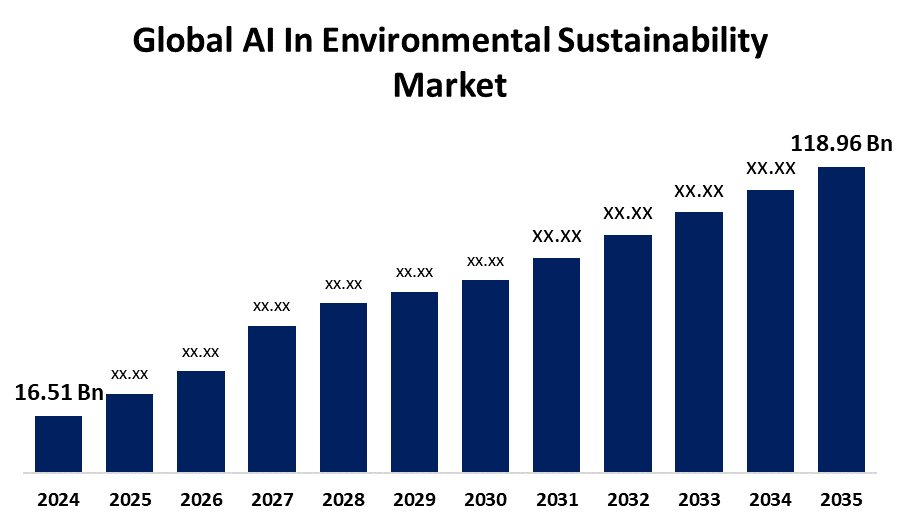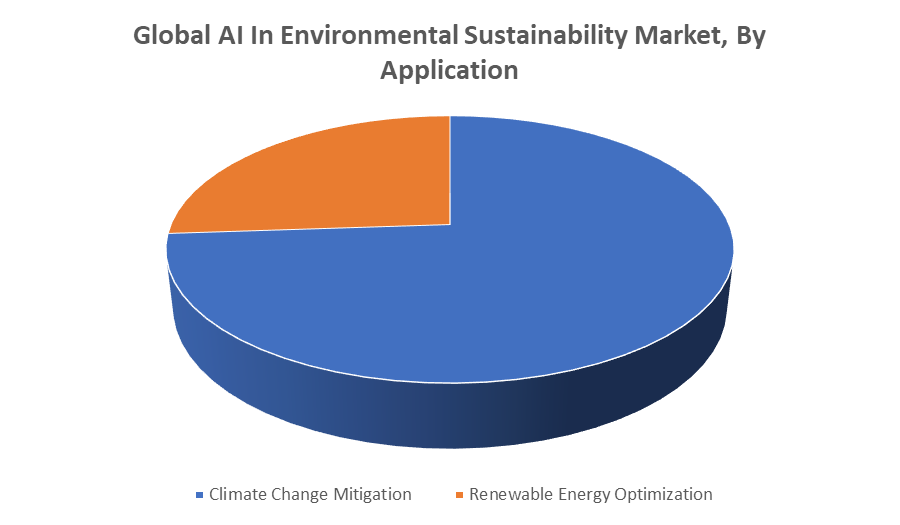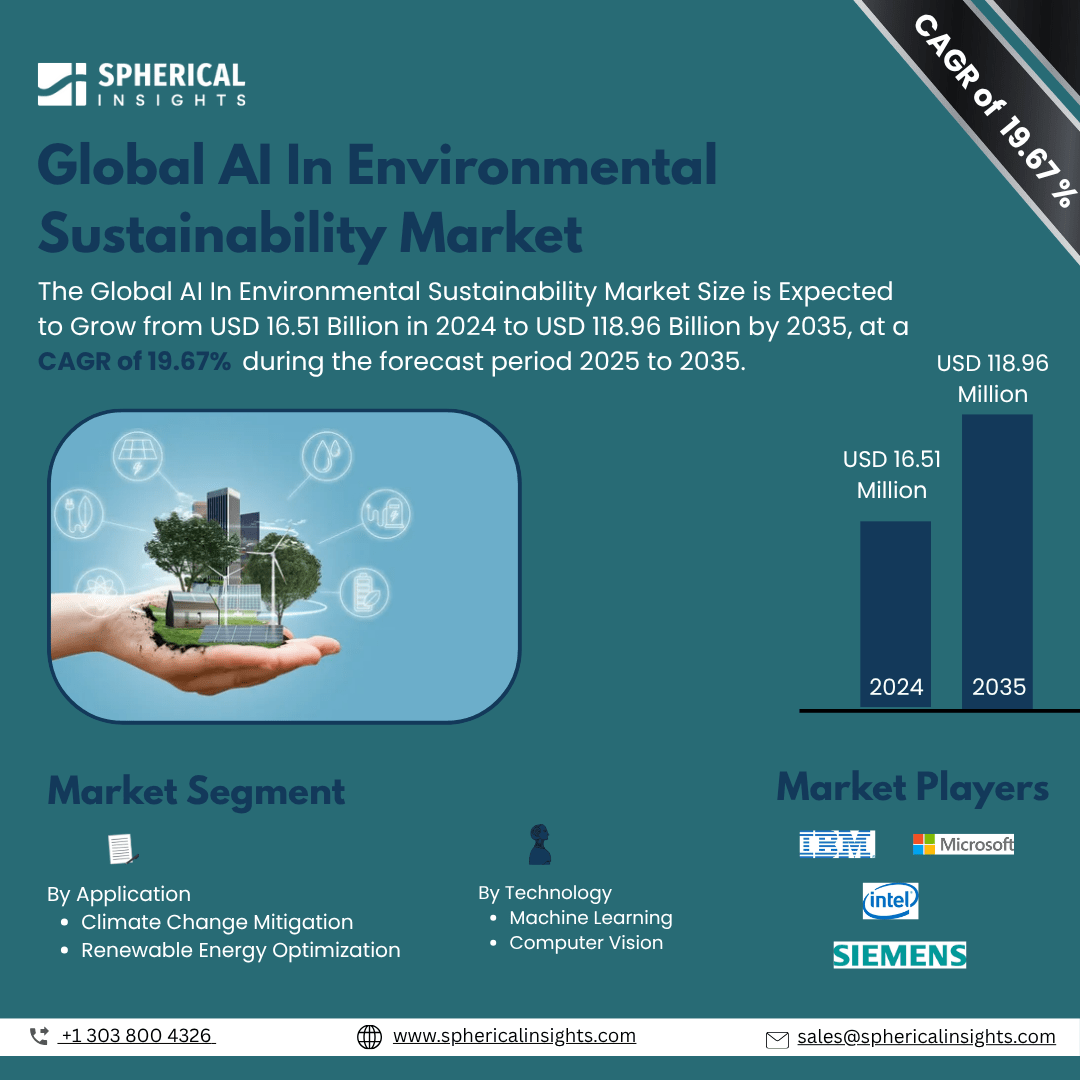Global AI In Environmental Sustainability Market Insights Forecasts to 2035
- The Global AI In Environmental Sustainability Market Size Was Estimated at USD 16.51 Billion in 2024
- The Market Size is Expected to Grow at a CAGR of around 19.67% from 2025 to 2035
- The Worldwide AI In Environmental Sustainability Market Size is Expected to Reach USD 118.96 Billion by 2035
- Asia Pacific is expected to grow the fastest during the forecast period.

AI In Environmental Sustainability Market
The global AI in environmental sustainability market involves the application of artificial intelligence technologies to support and enhance efforts aimed at protecting the environment. AI enables the analysis of large datasets related to climate, pollution, and natural resources, helping to identify patterns and predict environmental changes. Through machine learning and data analytics, AI assists in optimizing energy use, improving waste management, monitoring ecosystems, and facilitating smarter resource allocation. This integration of AI technologies promotes more efficient environmental monitoring and decision-making, enabling quicker responses to environmental threats. The market encompasses various sectors including agriculture, forestry, water management, and renewable energy, where AI tools are used to improve sustainability practices. Overall, the adoption of AI in environmental sustainability is transforming how environmental data is managed and utilized, fostering innovation in combating climate change and preserving natural habitats for future generations.
Attractive Opportunities in the AI In Environmental Sustainability Market
- Development of AI-powered early warning systems for natural disasters such as floods, wildfires, and hurricanes. These tools can provide timely alerts and actionable insights, helping to mitigate damage and save lives.
- Using AI to monitor endangered species and their habitats allows for better protection and management of ecosystems. This can enhance conservation efforts and support biodiversity preservation on a large scale.
- Combining AI with blockchain can improve traceability and sustainability in supply chains, promoting responsible sourcing and reducing environmental impact. This integration supports circular economy models and encourages eco-friendly business practices.
Global AI In Environmental Sustainability Market Dynamics
DRIVER: Rising awareness about environmental challenges like climate change
Rising awareness about environmental challenges like climate change, biodiversity loss, and pollution is creating a strong demand for advanced technological solutions. AI’s capability to analyze complex environmental data sets with speed and precision enhances the accuracy of forecasting and resource management. Progress in AI techniques such as machine learning, computer vision, and sensor integration is enabling smarter and more adaptive sustainability practices. Moreover, governments and corporations are increasingly leveraging AI tools to comply with environmental policies and drive green initiatives. Investments in clean energy, smart agriculture, and efficient waste management are also accelerating AI adoption. The growing necessity for real-time monitoring of ecosystems and natural resources further supports market growth, positioning AI as a vital component in global environmental protection efforts.
RESTRAINT: High implementation costs and the need for advanced infrastructure can limit adoption
High implementation costs and the need for advanced infrastructure can limit adoption, especially in developing regions. The complexity of integrating AI with existing environmental systems and datasets often requires specialized expertise, which is scarce and expensive. Additionally, concerns related to data privacy, security, and the quality of environmental data can hinder the effective deployment of AI solutions. The lack of standardized regulations and frameworks for AI in environmental applications creates uncertainty, slowing down investment and innovation. Moreover, AI models sometimes struggle with the unpredictability and variability inherent in natural ecosystems, which can reduce their reliability. Resistance to change from traditional industries and limited awareness about AI benefits in sustainability further restrict market expansion. Together, these factors pose significant obstacles to the widespread adoption and scalability of AI-driven environmental sustainability initiatives.
OPPORTUNITY: Development of innovative AI-powered tools for real-time disaster prediction and management
One key opportunity lies in the development of innovative AI-powered tools for real-time disaster prediction and management, such as early warning systems for floods, wildfires, and hurricanes. There is also significant potential in enhancing biodiversity conservation through AI-enabled species tracking and habitat monitoring, which can aid in protecting endangered ecosystems. Furthermore, the integration of AI with emerging technologies like blockchain can improve transparency and traceability in supply chains, promoting sustainable sourcing and reducing environmental impact. The increasing availability of satellite and remote sensing data offers new avenues for AI applications in large-scale environmental monitoring. Additionally, expanding AI’s role in circular economy models such as optimizing recycling processes and waste reduction can open fresh market possibilities. These opportunities highlight the vast potential for AI to drive innovative solutions that support long-term environmental sustainability in diverse sectors.
CHALLENGES: Environmental systems are highly complex and dynamic
Challenges in the AI for environmental sustainability market extend beyond common restraining factors and often relate to the unique nature of environmental data and applications. One major challenge is the scarcity of high-quality, labeled environmental datasets necessary for training effective AI models. Environmental systems are highly complex and dynamic, making it difficult for AI to accurately predict outcomes in changing conditions. Additionally, AI algorithms may sometimes produce biased or incomplete results due to uneven data representation across different regions or ecosystems. Interdisciplinary collaboration is also challenging, as experts in AI and environmental science must work closely, yet often come from different knowledge backgrounds and methodologies. Furthermore, translating AI insights into actionable environmental policies and practices can be slow and bureaucratic. There is also a challenge in ensuring AI solutions remain transparent and explainable to stakeholders, fostering trust and wider adoption. These challenges require ongoing research, improved data sharing, and stronger cooperation across sectors to fully realize AI’s potential in sustainability.
Global AI In Environmental Sustainability Market Ecosystem Analysis
The global AI in environmental sustainability market ecosystem includes AI technology providers offering machine learning, data analytics, and IoT solutions tailored to environmental needs. Key data sources such as satellites, sensors, and weather stations supply vital information for AI models. End-users span governments, industries, and research organizations applying AI to monitor ecosystems and manage resources sustainably. Cloud and data infrastructure providers support large-scale data processing. Regulatory bodies and collaborative partnerships between academia, industry, and NGOs also play essential roles in driving innovation and responsible AI adoption.
Based on the application, the climate change mitigation led the market and held the largest revenue share over the forecast period

The climate change mitigation segment dominance is due to the critical need for advanced technologies to monitor, predict, and reduce greenhouse gas emissions. AI enables more accurate climate modeling, efficient energy management, and optimized carbon capture processes, making it a vital tool in global efforts to combat climate change. Its widespread adoption across industries and governments has significantly contributed to the market’s revenue growth in this segment.
Based on the technology, the machine learning segment held the dominant position in the market and accounted for the largest revenue share during the forecast period
The machine learning segment held the dominant position in the market and accounted for the largest revenue share during the forecast period. This is attributed to machine learning’s ability to analyze vast and complex environmental data sets, enabling accurate predictions and informed decision-making. Its versatility across various applications such as climate modeling, resource management, and pollution control has made it a preferred technology. The continuous advancements and increasing adoption of machine learning have driven its leading market share.
North America is anticipated to hold the largest market share of the AI in environmental sustainability market during the forecast period
North America is anticipated to hold the largest market share in the AI in environmental sustainability market during the forecast period. This is driven by the region’s strong technological infrastructure, significant investments in AI research and development, and proactive government initiatives focused on environmental protection. Additionally, the presence of major AI companies and environmental organizations accelerates the adoption of AI solutions. North America’s emphasis on sustainable development and regulatory support further strengthens its leading position in the market.
Asia Pacific is expected to grow at the fastest CAGR in the AI in environmental sustainability market during the forecast period
Asia Pacific is expected to grow at the fastest CAGR in the AI in environmental sustainability market during the forecast period. This rapid growth is driven by increasing environmental concerns, expanding industrialization, and rising investments in smart technologies across the region. Governments in countries like China, India, and Japan are actively promoting AI adoption to tackle pollution, resource management, and climate change challenges. Additionally, the growing availability of data and advancements in AI infrastructure are fueling market expansion, positioning Asia Pacific as a key emerging player in environmental sustainability solutions.
Recent Development
- In August 2024, Microsoft introduced AI and data tools within its Microsoft Sustainability Manager, including Copilot and intelligent insights, to help businesses streamline emissions, waste, and water tracking under its Microsoft Cloud sustainability offerings.
- In March 2024, Schneider Electric announced the incorporation of innovative sustainable reporting features into their EcoStruxure IT data center, aimed at assisting operators in complying with the European Efficiency Directive.
Key Market Players
KEY PLAYERS IN THE AI IN ENVIRONMENTAL SUSTAINABILITY MARKET INCLUDE
- IBM Corporation
- Microsoft Corporation
- Google LLC (Alphabet Inc.)
- Schneider Electric SE
- Siemens AG
- Amazon Web Services (AWS)
- C3.ai, Inc.
- Intel Corporation
- General Electric Company (GE)
- NVIDIA Corporation
Market Segment
This study forecasts revenue at global, regional, and country levels from 2020 to 2035. Spherical Insights has segmented the AI in environmental sustainability market based on the below-mentioned segments:
Global AI In Environmental Sustainability Market, By Application
- Climate Change Mitigation
- Renewable Energy Optimization
Global AI In Environmental Sustainability Market, By Technology
- Machine Learning
- Computer Vision
Global AI In Environmental Sustainability Market, By Regional Analysis
- North America
- Europe
- Germany
- UK
- France
- Italy
- Spain
- Russia
- Rest of Europe
- Asia Pacific
- China
- Japan
- India
- South Korea
- Australia
- Rest of Asia Pacific
- South America
- Brazil
- Argentina
- Rest of South America
- Middle East & Africa
- UAE
- Saudi Arabia
- Qatar
- South Africa
- Rest of the Middle East & Africa





